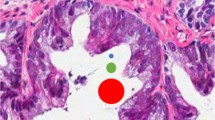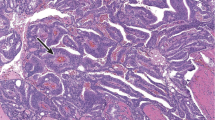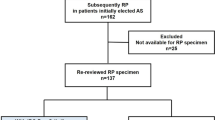Abstract
Purpose of Review
This review will discuss current understanding and management approaches of Intraductal carcinoma of the prostate (IDC-P). IDC-P is a histological finding characterized by neoplastic cells that expand but do not invade prostate ducts.
Recent Findings
The presence of IDC-P on a prostate biopsy is almost always associated with an invasive disease component and is independently associated with worse clinical outcomes in both early and late disease. These tumors are enriched for mutations in homologous DNA recombination repair (HRR) leading to high genomic instability. Multiparametric MRI with targeted biopsy may aid in diagnosis.
Summary
Given the poor clinical outcomes associated with this histologic entity, its presence in biopsies should warrant consideration of aggressive management.

Similar content being viewed by others
References
Papers of particular interest, published recently, have been highlighted as: • Of importance •• Of major importance
Siegel RL, Miller KD, Jemal A. Cancer statistics, 2020. CA Cancer J Clin. 2020;70(1):7–30.
Rajal B, Shah MZ. Prostate Biopsy Interpretation: An Illustrated Guide. 2nd ed: Springer; 2019.
Epstein JI, Egevad L, Amin MB, Delahunt B, Srigley JR, Humphrey PA. The 2014 International Society of Urological Pathology (ISUP) Consensus conference on Gleason grading of prostatic carcinoma: definition of grading patterns and proposal for a new grading system. Am J Surg Pathol. 2016;40(2):244–52.
Bostwick DG, Liu L, Brawer MK, Qian J. High-grade prostatic intraepithelial neoplasia. Rev Urol. 2004;6(4):171–9.
Tosoian JJ, Alam R, Ball MW, Carter HB, Epstein JI. Managing high-grade prostatic intraepithelial neoplasia (HGPIN) and atypical glands on prostate biopsy. Nat Rev Urol. 2018;15(1):55–66.
Partin AW. High-grade prostatic intraepithelial neoplasia on a prostate biopsy-what does it mean? Rev Urol. 2002;4(3):157–8.
Montironi R, Scarpelli M, Cheng L, Lopez-Beltran A, Zhou M, Montorsi F. Do not misinterpret intraductal carcinoma of the prostate as high-grade prostatic intraepithelial neoplasia! Eur Urol. 2012;62(3):518–22.
van Leenders GJLH, van der Kwast TH, Grignon DJ, Evans AJ, Kristiansen G, Kweldam CF, et al. The 2019 International Society of Urological Pathology (ISUP) consensus conference on grading of prostatic carcinoma. Am J Surg Pathol. 2020;44(8):e87–99.
McNeal JE, Reese JH, Redwine EA, Freiha FS, Stamey TA. Cribriform adenocarcinoma of the prostate. Cancer. 1986;58(8):1714–9.
Guo CC, Epstein JI. Intraductal carcinoma of the prostate on needle biopsy: histologic features and clinical significance. Mod Pathol. 2006;19(12):1528–35.
Montironi R, Zhou M, Magi-Galluzzi C, Epstein JI. Features and prognostic significance of intraductal carcinoma of the prostate. Eur Urol Oncol. 2018;1(1):21–8.
Rhamy RK, Buchanan RD, Spalding MJ. Intraductal carcinoma of the prostate gland. J Urol. 1973;109(3):457–60.
Kovi J, Jackson MA, Heshmat MY. Ductal spread in prostatic carcinoma. Cancer. 1985;56(7):1566–73.
McNeal JE. Significance of duct-acinar dysplasia in prostatic carcinogenesis. Prostate. 1988;13(2):91–102.
McNeal JE, Yemoto CE. Spread of adenocarcinoma within prostatic ducts and acini. Morphologic and clinical correlations. Am J Surg Pathol. 1996;20(7):802–14.
Watts K, Li J, Magi-Galluzzi C, Zhou M. Incidence and clinicopathological characteristics of intraductal carcinoma detected in prostate biopsies: a prospective cohort study. Histopathology. 2013;63(4):574–9.
Porter LH, Lawrence MG, Ilic D, Clouston D, Bolton DM, Frydenberg M, et al. Systematic review links the prevalence of intraductal carcinoma of the prostate to prostate cancer risk categories. Eur Urol. 2017;72(4):492–5.
•• Masoomian M, Downes MR, Sweet J, et al. Concordance of biopsy and prostatectomy diagnosis of intraductal and cribriform carcinoma in a prospectively collected data set. Histopathology. 2019;74(3):474–82 This paper demonstrates that the sensitivity for discovering IDC-P and cribiform architecture by prostate biopsy is poor and that mpMRI improves sensitivity.
Robinson BD, Epstein JI. Intraductal carcinoma of the prostate without invasive carcinoma on needle biopsy: emphasis on radical prostatectomy findings. J Urol. 2010;184(4):1328–33.
Humphrey PA, Moch H, Cubilla AL, Ulbright TM, Reuter VE. The 2016 WHO classification of tumours of the urinary system and male genital organs—part B: prostate and bladder tumours. Eur Urol. 2016;70(1):106–19.
Siddiqui MM, Rais-Bahrami S, Truong H, Stamatakis L, Vourganti S, Nix J, et al. Magnetic resonance imaging/ultrasound–fusion biopsy significantly upgrades prostate cancer versus systematic 12-core transrectal ultrasound biopsy. Eur Urol. 2013;64(5):713–9.
Walton Diaz A, Hoang AN, Turkbey B, Hong CW, Truong H, Sterling T, et al. Can magnetic resonance-ultrasound fusion biopsy improve cancer detection in enlarged prostates? J Urol. 2013;190(6):2020–5.
Kasivisvanathan V, Rannikko AS, Borghi M, Panebianco V, Mynderse LA, Vaarala MH, et al. MRI-targeted or standard biopsy for prostate-cancer diagnosis. N Engl J Med. 2018;378(19):1767–77.
Goel S, Shoag JE, Gross MD, al Hussein al Awamlh B, Robinson B, Khani F, et al. Concordance between biopsy and radical prostatectomy pathology in the era of targeted biopsy: a systematic review and meta-analysis. Eur Urol Oncol. 2020;3(1):10–20.
Truong M, Hollenberg G, Weinberg E, Messing EM, Miyamoto H, Frye TP. Impact of Gleason subtype on prostate cancer detection using multiparametric magnetic resonance imaging: correlation with final histopathology. J Urol. 2017;198(2):316–21.
•• Truong M, Feng C, Hollenberg G, et al. A Comprehensive analysis of cribriform morphology on magnetic resonance imaging/ultrasound fusion biopsy correlated with radical prostatectomy specimens. J Urol. 2018;199(1):106–13 This paper demonstrates that the sensitivity for discovering IDC-P and cribiform architecture by prostate biopsy is poor and that mpMRI improves sensitivity.
Prendeville S, Gertner M, Maganti M, Pintilie M, Perlis N, Toi A, et al. Role of magnetic resonance imaging targeted biopsy in detection of prostate cancer harboring adverse pathological features of intraductal carcinoma and invasive cribriform carcinoma. J Urol. 2018;200(1):104–13.
Tonttila PP, Ahtikoski A, Kuisma M, Pääkkö E, Hirvikoski P, Vaarala MH. Multiparametric MRI prior to radical prostatectomy identifies intraductal and cribriform growth patterns in prostate cancer. BJU Int. 2019;124(6):992–8.
Tannenbaum M. Endometrial tumors and/or associated carcinomas of prostate. Urology. 1975;6(3):372–5.
Dube VE, Farrow GM, Greene LF. Prostatic adenocarcinoma of ductal origin. Cancer. 1973;32(2):402–9.
Lawrence MG, Porter LH, Clouston D, et al. Knowing what’s growing: why ductal and intraductal prostate cancer matter. Sci Transl Med. 2020;12(533):eaaz0152.
Epstein JI, Allsbrook WC Jr, Amin MB, Egevad LL. The 2005 International Society of Urological Pathology (ISUP) consensus conference on Gleason grading of prostatic carcinoma. Am J Surg Pathol. 2005;29(9):1228–42.
Considine B, Petrylak DP. Novel targets and precision medicine for prostate cancer-part 2: tumor profiling and personalized therapy in patients with castration-resistant prostate cancer. Oncology (Williston Park). 2019;33(4):128–31.
Castro E, Mateo J, Olmos D, de Bono JS. Targeting DNA repair: the role of PARP inhibition in the treatment of castration-resistant prostate cancer. Cancer J. 2016;22(5):353–6.
Burdak-Rothkamm S, Mansour WY, Rothkamm K. DNA damage repair deficiency in prostate cancer. Trends Cancer. 2020;6(11):974–84.
Pritchard CC, Mateo J, Walsh MF, de Sarkar N, Abida W, Beltran H, et al. Inherited DNA-repair gene mutations in men with metastatic prostate cancer. N Engl J Med. 2016;375(5):443–53.
Risbridger GP, Taylor RA, Clouston D, Sliwinski A, Thorne H, Hunter S, et al. Patient-derived xenografts reveal that intraductal carcinoma of the prostate is a prominent pathology in BRCA2 mutation carriers with prostate cancer and correlates with poor prognosis. Eur Urol. 2015;67(3):496–503.
• Isaacsson Velho P, Silberstein JL, Markowski MC, et al. Intraductal/ductal histology and lymphovascular invasion are associated with germline DNA-repair gene mutations in prostate cancer. Prostate. 2018;78(5):401–7 This paper demonstrates that the presence of IDC-P/ductal histology is associated with HRR mutations.
Stopsack KH, Whittaker CA, Gerke TA, Loda M, Kantoff PW, Mucci LA, et al. Aneuploidy drives lethal progression in prostate cancer. Proc Natl Acad Sci U S A. 2019;116(23):11390–5.
KEYTRUDA. (pembrolizumab) [package insert]. Whitehouse Station: Merck Sharp & Dohme Corp.
• Chua MLK, Lo W, Pintilie M, et al. A prostate cancer “nimbosus”: genomic instability and SChLAP1 dysregulation underpin aggression of intraductal and cribriform subpathologies. Eur Urol. 2017;72(5):665–74 This paper demonstrates that the presence of IDC-P/cribriform histology is associated with greater genomic instability.
• Böttcher R, Kweldam CF, Livingstone J, et al. Cribriform and intraductal prostate cancer are associated with increased genomic instability and distinct genomic alterations. BMC Cancer. 2018;18(1):8 This paper demonstrates that the presence of IDC-P/cribriform histology is associated with greater genomic instability.
Bhandari V, Hoey C, Liu LY, Lalonde E, Ray J, Livingstone J, et al. Molecular landmarks of tumor hypoxia across cancer types. Nat Genet. 2019;51(2):308–18.
Koshiji M, To KK, Hammer S, et al. HIF-1alpha induces genetic instability by transcriptionally downregulating MutSalpha expression. Mol Cell. 2005;17(6):793–803.
Mihaylova VT, Bindra RS, Yuan J, Campisi D, Narayanan L, Jensen R, et al. Decreased expression of the DNA mismatch repair gene Mlh1 under hypoxic stress in mammalian cells. Mol Cell Biol. 2003;23(9):3265–73.
Gillard M, Lack J, Pontier A, Gandla D, Hatcher D, Sowalsky AG, et al. Integrative genomic analysis of coincident cancer foci implicates CTNNB1 and PTEN alterations in ductal prostate cancer. Eur Urol Focus. 2019;5(3):433–42.
Seipel AH, Whitington T, Delahunt B, Samaratunga H, Mayrhofer M, Wiklund P, et al. Genetic profile of ductal adenocarcinoma of the prostate. Hum Pathol. 2017;69:1–7.
Armenia J, Wankowicz SAM, Liu D, et al. The long tail of oncogenic drivers in prostate cancer. Nat Genet. 2018;50(5):645–51.
Wilcox G, Soh S, Chakraborty S, Scardino PT, Wheeler TM. Patterns of high-grade prostatic intraepithelial neoplasia associated with clinically aggressive prostate cancer. Hum Pathol. 1998;29(10):1119–23.
Kimura K, Tsuzuki T, Kato M, Saito AM, Sassa N, Ishida R, et al. Prognostic value of intraductal carcinoma of the prostate in radical prostatectomy specimens. Prostate. 2014;74(6):680–7.
Kato M, Tsuzuki T, Kimura K, Hirakawa A, Kinoshita F, Sassa N, et al. The presence of intraductal carcinoma of the prostate in needle biopsy is a significant prognostic factor for prostate cancer patients with distant metastasis at initial presentation. Mod Pathol. 2016;29(2):166–73.
Khani F, Epstein JI. Prostate biopsy specimens with Gleason 3+3=6 and intraductal carcinoma: radical prostatectomy findings and clinical outcomes. Am J Surg Pathol. 2015;39(10):1383–9.
•• Zhao J, Shen P, Sun G, et al. The prognostic implication of intraductal carcinoma of the prostate in metastatic castration-resistant prostate cancer and its potential predictive value in those treated with docetaxel or abiraterone as first-line therapy. Oncotarget. 2017;8(33):55374–83 This paper demonstrates that metastatic cancer that had IDC-P in the prostate biopsy had poor outcomes and that response to docetaxel appeared inferior to response to abiraterone, suggesting that prostate cancer associated with IDC-P might have unique response characteristics.
Network NCC. Prostate Cancer (Version 2.2020).
Cohen RJ, McNeal JE, Baillie T. Patterns of differentiation and proliferation in intraductal carcinoma of the prostate: significance for cancer progression. Prostate. 2000;43(1):11–9.
Varma M, Delahunt B, Egevad L, Samaratunga H, Kristiansen G. Intraductal carcinoma of the prostate: a critical re-appraisal. Virchows Arch. 2019;474(5):525–34.
• Trinh VQ, Benzerdjeb N, Chagnon-Monarque S, et al. Retrospective study on the benefit of adjuvant radiotherapy in men with intraductal carcinoma of prostate. Radiat Oncol. 2019;14(1):60 This paper demonstrated that the presence of IDC-P in a prostate biopsy is a risk factor for progression that might be mitigated by adjuvant radiation.
Kato M, Hirakawa A, Kobayashi Y, Yamamoto A, Ishida R, Kamihira O, et al. Response of intraductal carcinoma of the prostate to androgen deprivation therapy predicts prostate cancer prognosis in radical prostatectomy patients. Prostate. 2020;80(3):284–90.
de Bono J, Mateo J, Fizazi K, Saad F, Shore N, Sandhu S, et al. Olaparib for metastatic castration-resistant prostate cancer. N Engl J Med. 2020;382(22):2091–102.
Abida W, Cheng ML, Armenia J, Middha S, Autio KA, Vargas HA, et al. Analysis of the prevalence of microsatellite instability in prostate cancer and response to immune checkpoint blockade. JAMA Oncol. 2019;5(4):471–8.
Le DT, Uram JN, Wang H, et al. PD-1 Blockade in tumors with mismatch-repair deficiency. N Engl J Med. 2015;372(26):2509–20.
Vivanco I, Sawyers CL. The phosphatidylinositol 3-Kinase AKT pathway in human cancer. Nat Rev Cancer. 2002;2(7):489–501.
Considine B, Petrylak DP. Integrating novel targets and precision medicine into prostate cancer care-part 1: the non-androgen-targetable pathways in castration-resistant prostate cancer. Oncology (Williston Park). 2019;33(3):113–8.
Author information
Authors and Affiliations
Corresponding author
Ethics declarations
Conflict of Interest
Bryden Considine declares that he has no conflict of interest. Adebowale Adeniran declares that he has no conflict of interest. Michael E. Hurwitz has received funding for clinical trials from Achilles Therapeutics, Apexigen, Arrowhead Pharmaceuticals, Astellas, AstraZeneca, Bayer, Bristol-Myers Squibb, CRISPR Therapeutics, Corvus Pharmaceuticals, Eli Lilly, Endocyte, Genentech, Genmab, GlaxoSmithKline, Innocrin Pharmaceuticals, Iovance Biotherapeutics, KSQ Therapeutics, Merck, Nektar Therapeutics, Novartis, Pfizer, Progenics, Sanofi Aventis, Seattle Genetics, Tmunity Therapeutics, Torque Therapeutics, and Unum Therapeutics; has received compensation from Bristol-Myers Squibb, CRISPR Therapeutics, Exelixis, Merck, and Nektar Therapeutics for participation on advisory boards; and his spouse has received honoraria from Arvinas and Gamida Cell Ltd.
Additional information
Publisher’s Note
Springer Nature remains neutral with regard to jurisdictional claims in published maps and institutional affiliations.
This article is part of the Topical Collection on Genitourinary Cancers
Rights and permissions
About this article
Cite this article
Considine, B., Adeniran, A. & Hurwitz, M.E. Current Understanding and Management of Intraductal Carcinoma of the Prostate. Curr Oncol Rep 23, 110 (2021). https://doi.org/10.1007/s11912-021-01090-2
Accepted:
Published:
DOI: https://doi.org/10.1007/s11912-021-01090-2




